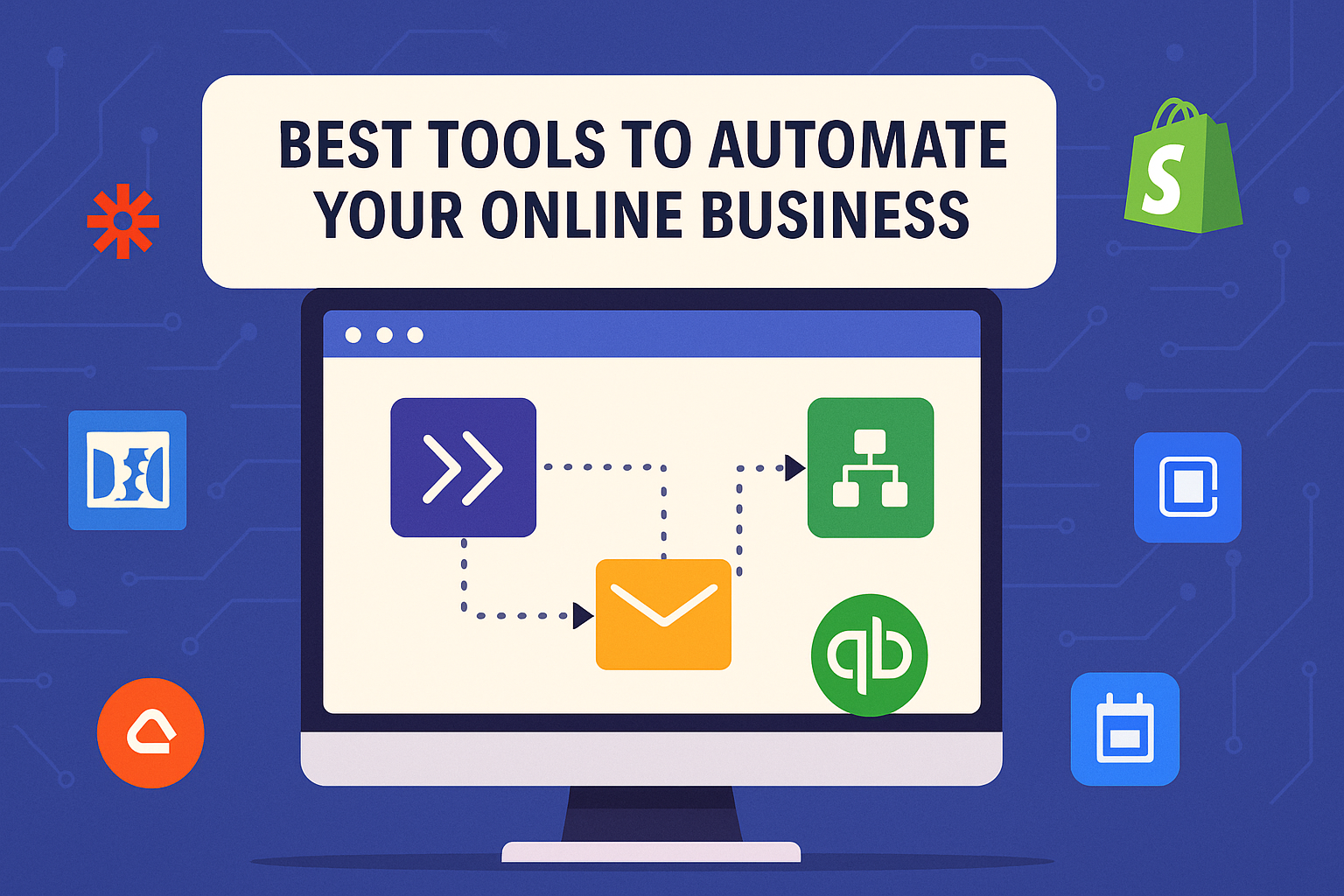In today’s fast-paced digital world, automation isn’t optional — it’s essential. Whether you’re a solopreneur or scaling your eCommerce empire, using the right tools to automate repetitive tasks can save hours, reduce errors, and supercharge growth.
- 1. Zapier – Your Automation Backbone
- 2. ActiveCampaign – Email + CRM Automation
- 3. ManyChat – Chatbot Automation for Facebook & Instagram
- 4. Shopify Flow – eCommerce Workflow Automation
- 5. ClickFunnels – Sales Funnel Automation
- 6. QuickBooks Online – Automated Accounting & Invoicing
- 7. Make (formerly Integromat) – Advanced Automation Platform
- 8. Calendly – Automated Appointment Booking
- 9. HubSpot – All-in-One Business Automation Platform
- Summary Table
- Final Thoughts
Here’s a breakdown of the top automation tools across marketing, sales, operations, and customer support.
1. Zapier – Your Automation Backbone
What It Does: Connects 5,000+ apps to automate workflows without coding.
Top Use Cases:
- Auto-send emails when new leads arrive
- Sync form submissions to Google Sheets
- Post social media updates from blog RSS
Why It’s Great: It acts like digital glue between all your tools.
2. ActiveCampaign – Email + CRM Automation
What It Does: Automates email campaigns, customer journeys, and lead scoring.
Top Use Cases:
- Welcome email sequences
- Abandoned cart recovery
- CRM-based task assignments
Why It’s Great: Combines automation, email, and CRM into one powerful platform.
3. ManyChat – Chatbot Automation for Facebook & Instagram
What It Does: Builds AI-powered chat flows to respond to users 24/7.
Top Use Cases:
- Auto-reply to DMs
- Lead qualification via Messenger
- Flash sale announcements
Why It’s Great: Converts conversations into customers on autopilot.
4. Shopify Flow – eCommerce Workflow Automation
What It Does: Automates eCommerce operations like inventory alerts, tagging VIP customers, and email triggers.
Top Use Cases:
- Tagging repeat customers
- Auto-canceling high-risk orders
- Notifying suppliers when stock is low
Why It’s Great: Built for Shopify merchants with zero code required.
5. ClickFunnels – Sales Funnel Automation
What It Does: Creates automated sales funnels with upsells, email sequences, and checkout pages.
Top Use Cases:
- Tripwire funnels
- Webinar registration flows
- Membership site access
Why It’s Great: Perfect for solopreneurs and info product creators.
Launch Funnels with ClickFunnels
6. QuickBooks Online – Automated Accounting & Invoicing
What It Does: Automates income/expense tracking, recurring invoices, and tax reports.
Top Use Cases:
- Auto-categorizing transactions
- Sending payment reminders
- Generating monthly reports
Why It’s Great: Takes the headache out of bookkeeping.
7. Make (formerly Integromat) – Advanced Automation Platform
What It Does: Automates multi-step workflows and data syncing across apps.
Top Use Cases:
- Complex logic-based automations
- Bulk operations across APIs
- Conditional task sequences
Why It’s Great: More advanced and flexible than Zapier for technical users.
8. Calendly – Automated Appointment Booking
What It Does: Automates meeting scheduling across time zones.
Top Use Cases:
- Sales calls and onboarding meetings
- Coaching or consulting sessions
- Podcast guest scheduling
Why It’s Great: No more back-and-forth emails to book a call.
9. HubSpot – All-in-One Business Automation Platform
What It Does: Offers CRM, email, sales, support, and marketing automation in one dashboard.
Top Use Cases:
- Lead nurturing workflows
- Pipeline automation
- Ticket and support automation
Why It’s Great: Great for startups ready to scale.
Summary Table
| Tool | Primary Use | Best For | Link |
|---|---|---|---|
| Zapier | App-to-App Automation | Everyone | zapier.com |
| ActiveCampaign | Email + CRM Automation | Email marketers & coaches | activecampaign.com |
| ManyChat | Messenger Automation | Social sellers | manychat.com |
| Shopify Flow | eCommerce Workflows | Shopify store owners | apps.shopify.com/flow |
| ClickFunnels | Funnel Automation | Info product sellers | clickfunnels.com |
| QuickBooks | Accounting + Invoicing | Freelancers & SMBs | quickbooks.intuit.com |
| Make | Custom Automations | Developers & power users | make.com |
| Calendly | Appointment Scheduling | Consultants & agencies | calendly.com |
| HubSpot | Full Business Automation | Startups & scaling teams | hubspot.com |
Final Thoughts
Automating your online business doesn’t mean removing the human touch — it means freeing up your time to focus on growth, creativity, and results.
Choose the tools that align with your business stage and goals. Start small, test often, and build a tech stack that works for you — not the other way around.
